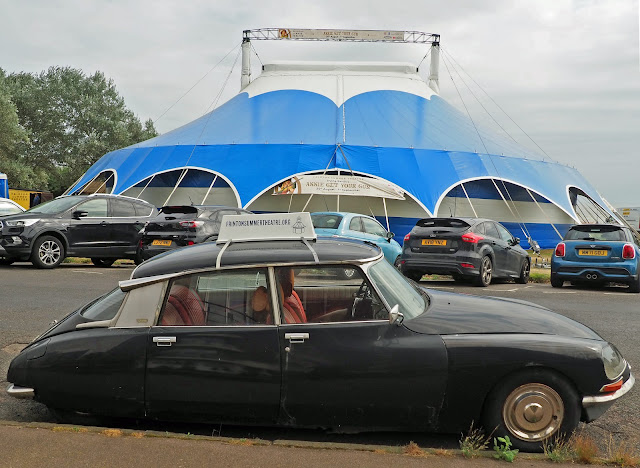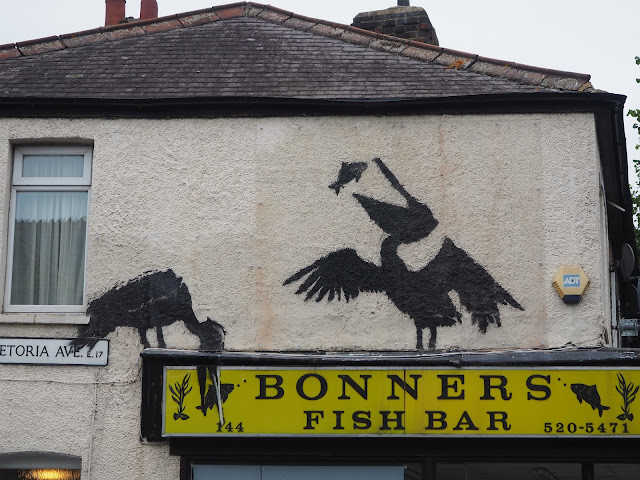Saturday, September 14, 2024
Tuesday, September 3, 2024
WALKING WITH ARCHITECTURE (AND CARS)
And so we went to Frinton on Sea, in Essex, and not for the first time.
Like many people I usually go there to walk around and stare at the modernist architecture in the Frinton Park Estate and although we certainly did do that, I thought I needed a new angle, or at least variation on an old one. So I continued my comparatively recent obsession with circular windows, of which there was no shortage.
That was fine, but then I noticed there were also quite a few cool old cars on the street, which I hadn’t been expecting.
It’s an odd thing isn’t it, any walk, every walk, is improved by the presence of interesting or curious architecture and any street is improved by the presence of cool old cars
This is why American Street Photographers of the 1960s and 70s, most of them walkers by necessities, had life so easy in one sense. Point your camera towards a mid of mine-period architecture or even a garage, and include a car with fins, and it’s hard to go wrong.
But times change, I find modern architecture, whether good or bad, infinitely fascinating, whereas modern cars rarely look like anything at all. And it must be said that in Frinton I never found a cool car and a cool piece of architecture in the same frame, unless a marquee counts as architecture.
And I see there’s also a new book forthcoming from the modernist titled A Time ⋅ A Place, a book in which 'every "Car of the Year" (1964-1982) is paired with a building completed in the same year' - photographed by Daniel Hopkinson, researched and written by John Piercy Holroyd.
OMG, I can barely imagine the amount of work that went into that and I certainly didn’t put that amount of work into a day trip to Frinton, obviously.
There used to be a trope that said ‘Harwich for the Continent, Frinton for the Incontinent’ a sneer directed at old and weak-bladdered Essex holidaymakers. But insult or not, I found Frinton to be very well supplied with toilets, and just as important, very well signposted.
And the architecture of the main toilet on the sea front is understatedly epic – though you do have to pay 20 pence to get in there. A small price to pay.
Wednesday, August 28, 2024
TO BE A WALKING PILGRIM
Some folks walk the Camino de Santiago:
Some folks walk the Great Wall of China:
Some folks head for the deep north, like our pal Basho:
Me, I went to Walthamstow and walked from the tube station to see the Banksy mural on the side of Bonners Fish Bar (no apostrophe). It looked just like this – protective Perspex in place.
The shop was closed, and obviously had been for a while, perhaps for an annual summer holiday, and a great pile of mail had been pushed through the letterbox and was lying all over the floor.
It was a great missed commercial opportunity, I’d have thought – ‘Get your Banksy chip butty right here!’
But Banksy wasn’t the only artist whose work could be seen as you walked the streets of Walthamstow. Here for example is the Walthamstow Sculpture Park, in somebody’s front window:
And here’s whatever this is:
Sometimes it feels good to be a pilgrim.
Friday, August 23, 2024
THE PERFUMED CASCADE
Regular readers of this blog (if there are any) may remember that about a year ago I agreed to lead a literary walk based in Richmond, and I had the idea of doing a route that took in the school where Sir Richard Francis Burton was educated (or at least taught), and ended at the Orleans House Gallery which houses the Burton Collection, an archive which among other gems contains plaster casts of one of Burton’s hands, and one of his feet – the left in both cases. I thought it would be a fitting climax to a walk if we ended up staring at a plaster cast of someone’s foot. The case looks like this on the Orleans House website.
The idea didn’t come off because although the Burton Collection could, and can, be seen on request, the gallery at that time, they told me, was in the process of changing curators so things were ‘a bit chaotic’ and there’d be no chance of seeing it for a few months. So I led a different walk.
For some of us, Burton is a fascinating though paradoxical and contested figure, on the one hand an intrepid explorer, a proto-anthropologist and sexologist; on the other a man with some less than enlightened views on race and sex. I couldn’t have said that Burton had been ‘cancelled’ by Orleans House, but it certainly seemed he’d been sidelined.
Still, thanks to the good people involved with the Sir Richard Francis Burton Society, chiefly Martin Norris, a small group of us went into the collection recently and we were allowed an hour to look at, though not touch, items from the collection. These included, among other things, writing implements, a sword, photograph albums, a cigar case and a fez.
And there, sure enough, were the casts of Burton’s hand and foot. I took a photo - not a very good one because of the overhead lighting and all reflections - but at least it proves I was actually there.
I’m still working out how much of a walker Burton was, but one of the great things about our archive visit was a chance to look at some of Burton’s shoes. I’m sure you can tell a lot by looking at a dead man’s shoes. I recall being horrified as a kid when my grandfather died and various male relatives started trying on his shoes to see if they fitted and whether they could use them. Now it seems a perfectly reasonable and rather touching thing to do. There was definitely no trying on of Burton’s footwear, obviously.
There were fencing shoes, slippers, a wooden clog, some very fine boots. The patterns of wear were interesting, at least one pair looked as though it might have been reheeled.
It was a great afternoon. The visit wasn’t exactly a walking expedition but we did walk to Orleans House from the pub where we met near Twickenham station, and on the way we saw a pair of marble buttocks peeping out at us over a wall and behind railings. So on the way back we took a closer look.
The buttocks belong to one of a number of Carrera marble statues, the Oceanides, part of the York House Cascade, in York House Gardens.
Like Burton himself these do have a convoluted history. As I understand it, they were carved somewhere near the turn of the 19th to the 20th century by Oscar Spalmach, and they passed through the hands of Whitaker Wright, who intended to use them at his estate in Surrey. However, in 1904 Wright was found guilty of fraud, and committed suicide by swallowing cyanide in an anteroom of the Royal Courts of Justice.
York House belonged to Sir Ratanji Tata, described by some sources as ‘an Indian merchant prince’ and he bought the statues in 1909, still in packing cases, to adorn his property. Tata died in 1918, and when his wife returned to India she sold York House to Twickenham Urban District Council for use as municipal offices, and the statues were part of the deal. After many decades of neglect and vandalism the statues were eventually saved and restored.
And there they are today, naked, shameless, uncancelled. Sir Richard Francis Burton would surely have loved them. The Oceanides – not a pair of shoes between them.
Thursday, August 8, 2024
TIME OF THE SIGNS
I enjoy a good sign while I’m walking. Who doesn’t? They can be informative, decorative, perplexing, absurd, and no doubt many other things too.
Suppose you were walking in Myland (it’s part of Colchester) and you saw this one ‘Myland Welcomes Careful Drivers,’
Would you think,
a) that they don’t welcome careful walkers?
b) that you can walk as carelessly as you like, and you’re still welcome?
Or would you have better things to think about?
Signs with missing letters are always fun and in this case there’s no doubt what the sign means, but it does make me wonder how many letters a sign can lose before it becomes utterly incomprehensible.
That temporary bus stop sign had obviously seen a lot of use but nearby was this absolutely pristine sign telling me that the crossing was out of use. I suppose time will take its toll.
Not so far away was this, a signal, rather than a sign.
And here’s a sign from the company in charge of the discarded lights, temporary bus stops and out of order crossings, and no doubt much else:
I didn’t even know there was any such thing as the ‘Traffic Industry.’ ‘What you doing these days Bob?’ ‘Oh I’m working in the Traffic Industry, you know, supporting it.’
Of course it’s always good for a walker to be warned when the footpath (or indeed footway) ahead is closed:
but it’s a little disappointing when you get there and find it’s not so much closed as very slightly diverted:
Now, if you’re looking for the ‘site compound’, it’s no doubt very useful to have a sign directing you there, though this one does seem to be up in the sky.
As for parking regulations – forget about it:
And finally in the Asda car park, at the end of my walk, there was a sign telling me to have a safe journey, which I’d already had, but no doubt there are other journeys ahead, which I hope will be safe, and maybe signs will play their part.











































